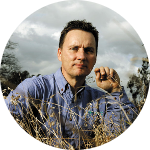-
Member Login
- Home
- About
- Institute Groups
- Membership
- Events
- News & Publications
- Institute Programs
- Resources
- Jobs Board
- Contact Us
- Site Info
Paul Gibson-Roy
Paul Gibson-Roy
Abstract | Restoring threatened native plant communities to roadsides
Australian native grassy ecosystems are diminished to a tiny fraction of their original range and are among our most threatened plant communities. It is possible to traverse many hundreds of kilometres of rural roadways in eastern Australia and observe little or no native ground-layer vegetation on roadsides or within the broader landscape.
While in recent decades there has been growing evidence across several states that suggest it is feasible to restore complex native grassy communities there has been relatively little uptake or support for these approaches. Conversely, there are several million kilometers of road spanning the continental US and 29 million ha of roadside landscaping, much focussing on reinstating native herbaceous species. In that country long stretches of highway where native wildflowers bloom in profusion are not uncommon. Native plants are viewed as beneficial by many US Departments of Transport. Importantly, many recognise that road corridors represent among the largest pieces of continuous land available for biodiversity habitat if planted to native vegetation. They are also valued for providing important functional and amenity roles that can stabilise verges, reduce ongoing vegetation maintenance costs and provide great amenity value. Native wildflowers are documented to increase the ‘wildflower tourism’ potential in many states and regions.
This presentation examines the US example of restoring native plant diversity to its roadsides and explores the possibility of Australia following this example.
Bio | Paul Gibson-Roy
 Dr Paul Gibson Roy (Lead Scientist: Greening Australia) has had a long term involvement in the restoration of wildflower grasslands and grassy woodlands, both threatened plant communities. In 2004 he instigated the Grassy Groundcover Research Project, a multiregional research partnership between Greening Australia (Victoria) and the University of Melbourne, which demonstrated the feasibility of restoring complex native herbaceous vegetation on agricultural lands by direct seeding. In 2016 he toured the US to investigate firsthand the native seed production and prairie restoration sectors.
Dr Paul Gibson Roy (Lead Scientist: Greening Australia) has had a long term involvement in the restoration of wildflower grasslands and grassy woodlands, both threatened plant communities. In 2004 he instigated the Grassy Groundcover Research Project, a multiregional research partnership between Greening Australia (Victoria) and the University of Melbourne, which demonstrated the feasibility of restoring complex native herbaceous vegetation on agricultural lands by direct seeding. In 2016 he toured the US to investigate firsthand the native seed production and prairie restoration sectors.
We acknowledge and value the rights and interests of Indigenous Peoples in the protection and management of environmental values through their involvement in decisions and processes, and the application of traditional Indigenous knowledge.

